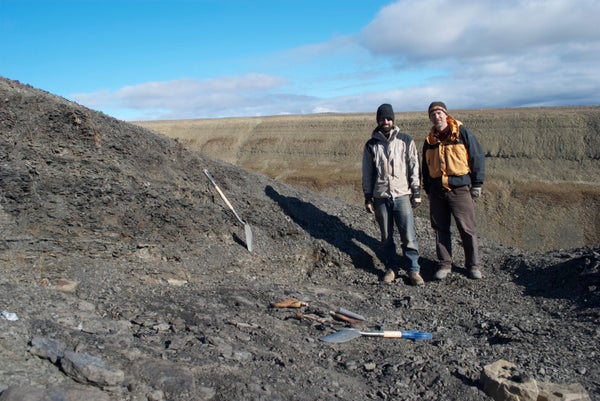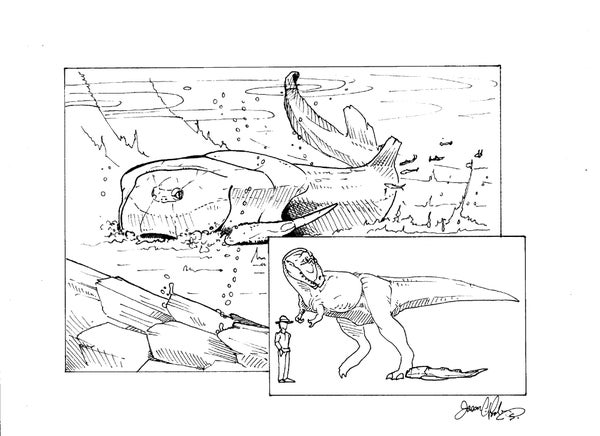This article was published in Scientific American’s former blog network and reflects the views of the author, not necessarily those of Scientific American
Naming fossils can be tricky. The titles are meant to be permanent, evoking something of where the ancient species was found, who uncovered it, or some essential facet of its nature. In 1933, for example, paleontologist W. Gross looked at a particularly large example of an armored fossil fish called Bothriolepis and named it as a new species - Bothriolepis maxima, the greatest species of its Devonian ilk. Clearly Gross expected the superlative to stick. What Gross couldn't have known is that there were larger Bothriolepis out there, yet to be found, waiting to be uncovered among the chilly outcrops of Nunavut, Canada.
Paleontologist Jason Downs and colleagues, needing something a tier above maxima, have named their fossil fish Bothriolepis rex. There's no fish quite like it alive today. This 370 million year old swimmer was encased in a suit of armor plates, wearing the bony part of its skeleton on the outside. This new species is far larger than its next challenger, however. Downs and coauthors estimated that Bothriolepis rex was about five and a half feet long, or about thirty percent larger than Gross' B. maxima.
But why all the armor? Downs and colleagues review a couple of possibilities. One is that all those thick bones acted as ballast. Bothriolepis was a big fish and a likely grubbed around in the mud for little plant morsels. At such size, Downs and coauthors note, dense armor plates would have helped B. rex stay closer to the bottom with less effort. On top of that, the thick bones of B. rex likely acted as protection. The Devonian was a fish-eat-fish world, and other fossils found near Bothriolepis rex give away the presence of coelacanth relatives - called sarcopterygians - with piercing teeth and possibly king-sized appetites.

Paleontologists Jason Downs (left) and Ted Daeschler (right) at the B. rex discovery site. Credit: Drexel University
On supporting science journalism
If you're enjoying this article, consider supporting our award-winning journalism by subscribing. By purchasing a subscription you are helping to ensure the future of impactful stories about the discoveries and ideas shaping our world today.
Fossil Facts
Name: Bothriolepis rex
Meaning: "Pitted scale king."
Age: Devonian, about 370 million years old.
Where in the world?: Nunavut, Canada.
What sort of critter?: An armored fish known as an antiarch.
Size: About five and a half feet long.
How much of the creature’s body is known?: Plates of the external armor.
Reference:
Downs, J., Daeschler, E., Garcia, V., Shubin, N. 2016. A new large-bodied species of Bothriolepis (Antiarchi) from the Upper Devonian of Ellesmere Island, Nunavut, Canada. Journal of Vertebrate Paleontology. doi: 10.1080/02724634.2016.1221833
Previous Paleo Profiles:
The Light-Footed Lizard The Maoming Cat Knight’s Egyptian Bat The La Luna Snake The Rio do Rasto Tooth Bob Weir's Otter Egypt's Canine Beast The Vastan Mine Tapir Pangu's Wing The Dawn Megamouth The Genga Lizard The Micro Lion The Mystery Titanosaur The Echo Hunter The Lo Hueco Titan The Three-Branched Cicada The Monster of Minden The Pig-Footed Bandicoot Hayden's Rattlesnake Demon The Evasive Ostrich Seer The Paradoxical Mega Shark The Tiny Beardogs
